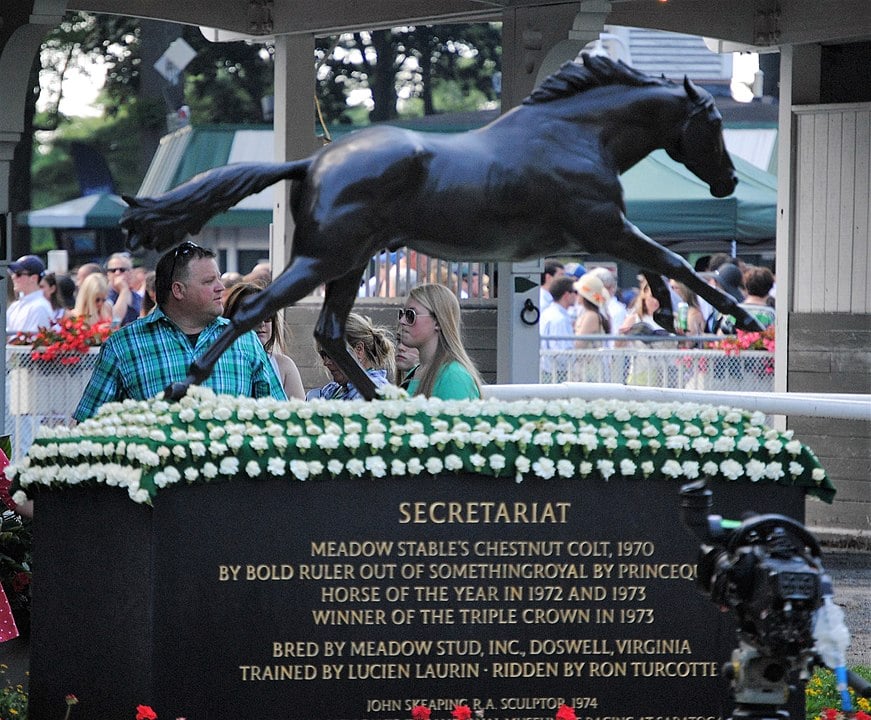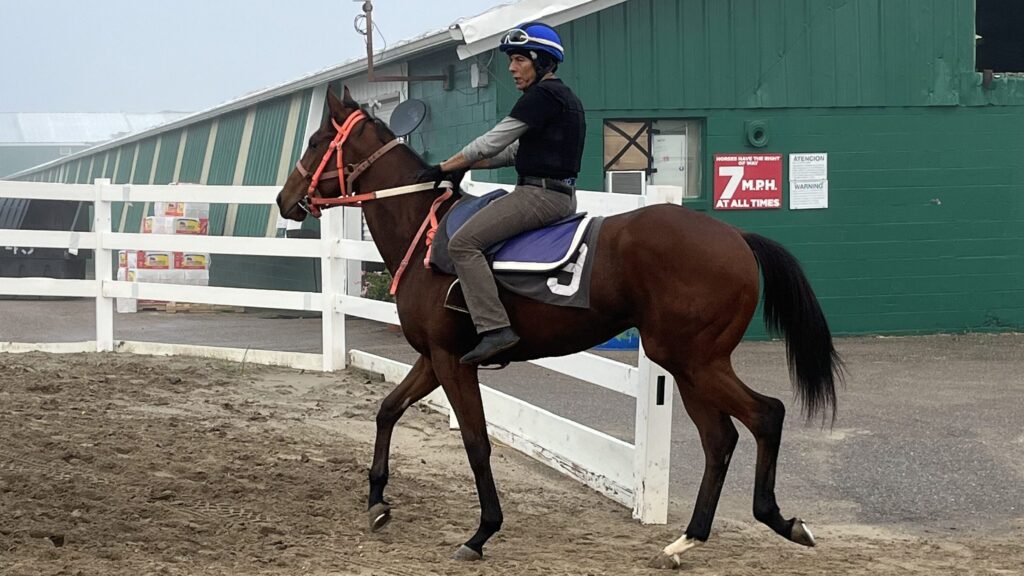Last updated: June 29, 2025
The name Secretariat conjures images of speed, power, and a racing legend unmatched in history. But was he truly the fastest? This question has sparked endless debates among horse racing fans. As someone with a lifelong dedication to horses and years of experience owning and training both racing Quarter Horses and Thoroughbreds, I’ve often wondered the same.
In this article, we’ll uncover the facts behind Secretariat’s record-shattering performances, explore his unique physical traits, and analyze the science behind his speed to determine if he truly deserves the title of the fastest horse ever.

Secretariat’s Early Years: Pedigree and Development of a Racing Legend.
Birth and Lineage
Secretariat was born on March 30, 1970, at Meadow Stud in Virginia. His sire, Bold Ruler, was a dominant stallion known for passing on speed and stamina, while his dam, Somethingroyal, contributed strength and durability. Together, they created a genetic foundation that made Secretariat a standout even before he set hoof on the track.
Meadow Stud’s Historical Significance
Meadow Stud, founded by Christopher Chenery in the 1930s, had a long-standing reputation for producing quality Thoroughbreds well before Secretariat’s birth. Though it didn’t achieve national fame until the 1970s, Meadow Stud laid the groundwork for its success through meticulous breeding programs that prioritized speed and stamina.
Early Development
From an early age, Secretariat stood out for his intelligence, calm temperament, and natural athleticism. His handlers noted his “beautiful fluid motion,” as described by his exercise rider, Jim Gaffney. This, coupled with his exceptional conformation, set the stage for his remarkable career.
Secretariat’s Record-Shattering Performances
Secretariat’s Breakthrough: Dominating the 1972 Season
Secretariat’s two-year-old campaign was nothing short of dominant. He won major stakes races, including the Sanford Stakes (after a controversial disqualification), Hopeful Stakes, and Champagne Stakes. His consistency earned him the title of Horse of the Year, a rare honor for a two-year-old.
The Triple Crown Year: Secretariat’s Historic 1973
- Kentucky Derby: Secretariat broke the two-minute barrier with a time of 1:59 2/5, running each quarter-mile faster than the previous one—an extraordinary feat known as negative splits. His performance remains unmatched in the history of the Derby.
- Preakness Stakes: Despite a timing controversy, Secretariat’s official time of 1:53 set a new record. His explosive move on the backstretch stunned viewers, demonstrating a remarkable combination of speed and strategy.
- Belmont Stakes: Secretariat’s iconic 31-length victory in a record-breaking 2:24 for 1½ miles remains one of the greatest performances in sports history. To put it in perspective, his mile fraction of 1:34 1/5 was faster than the Belmont mile record set by his sire, Bold Ruler. During the race, Anderson’s commentary captured the awe of the moment: “Secretariat is widening now! He is moving like a tremendous machine!” Source: Sports Illustrated
Comparison of Triple Crown Race Times
| Race | Secretariat’s Time | Record Before Secretariat | Improvement |
|---|---|---|---|
| Kentucky Derby | 1:59 2/5 | 2:00 | -0.4 sec |
| Preakness Stakes | 1:53 | 1:54 | -1 sec |
| Belmont Stakes | 2:24 | 2:26.6 | -2.6 sec |
Beyond the Triple Crown: Secretariat’s Other Iconic Wins
Beyond the Triple Crown, Secretariat won the Arlington Invitational and the Marlboro Cup, defeating older, more experienced horses. His final race at Woodbine demonstrated his versatility by showcasing his dominance on turf.
For a firsthand experience of this historic moment, you can watch the original race footage below:
Secretariat’s Build: The Physical Traits Behind His Dominance
Standing 16.2 hands tall and weighing over 1,100 pounds, Secretariat’s physical presence was extraordinary. His massive chest, so large it required a custom-made girth, and his powerful hindquarters contributed to his unparalleled propulsion. Compared to the average racehorse, Secretariat’s build was exceptional. While most racehorses have strong hindquarters, his were notably more muscular and well-defined, enabling unmatched power with each stride.
Experts have described his conformation as “nearly perfect.” Charles Hatton, a renowned sportswriter, famously remarked, “His only point of reference is himself.” Secretariat’s deep barrel, sloping shoulders, and balanced proportions allowed for optimal energy efficiency and an effortless stride. These traits, combined with his long, fluid motion, set him apart as a true outlier among equine athletes.
His stride was equally remarkable. Estimated at 25 feet, it allowed him to cover ground with incredible efficiency. Many described his smooth, rhythmic gait as poetry in motion, a visual testament to his unique biomechanics.
Learn More: For a deeper dive into the importance of conformation in horses, visit Horse Conformation and Performance.

The Science Behind Secretariat’s Speed
Secretariat’s Physiology: Unraveling the Factors Behind His Speed
Secretariat’s heart, estimated to weigh over 20 pounds—more than twice the size of an average horse’s heart—was a key factor in his dominance. This rare trait, documented by the Kentucky Derby Museum, allowed superior oxygen circulation, providing unmatched stamina and endurance. Additionally, his muscle composition combined fast-twitch and slow-twitch fibers, enabling both explosive acceleration and sustained speed.
Performance Metrics: Measuring Secretariat’s Greatness
Horse racing performance metrics, such as Beyer Speed Figures and Timeform Ratings, are essential tools for understanding a racehorse’s abilities. These systems quantify performance by accounting for variables like track conditions, competition, and pace, offering a standardized way to compare horses across different races and eras. Secretariat consistently ranked at the top of these metrics, underscoring his place as one of the greatest racehorses of all time.
- Beyer Speed Figures: These quantify a horse’s performance by adjusting for factors like track conditions and competition level. Secretariat’s figures consistently exceeded those of his contemporaries, often considered “off the charts” for his era. Learn more about Beyer Speed Figures.
- Timeform Ratings: Developed in Europe, these ratings assess global performance by evaluating pace, finishing position, and competition quality. Secretariat’s high Timeform Ratings solidified his reputation as one of the greatest racehorses of all time.
Comparison with Other Greats
While Man o’ War is often regarded as one of the greatest racehorses, he did not compete in the Triple Crown, making direct comparisons with Secretariat difficult. However, Secretariat’s record-breaking times and ability to maintain peak performance across multiple distances remain unparalleled in the history of horse racing.
Learn More: Curious about the factors that make horses run fast? Visit What Makes Horses So Fast?.
To better understand the unique qualities of Secretariat, Man o’ War, and Seabiscuit, the following graph compares key metrics, including stride length, average speed, and major career wins.

Legacy and Impact of Secretariat
Secretariat’s impact extends beyond his racing career, shaping horse racing history, breeding practices, and popular culture.
Cultural Impact
Secretariat transcended horse racing, becoming a cultural icon through his incredible career and enduring story. The Disney movie Secretariat (2010) dramatized his journey, introducing his achievements and the determination of his owner, Penny Chenery, to a new generation. Alongside this cinematic homage, Secretariat’s legacy is celebrated through books, documentaries, statues, and annual tributes, ensuring his place as a household name.
Breeding Legacy
While Secretariat’s career as a sire was modest, his daughters became highly influential broodmares, shaping future generations of racehorses. Through their lineage, Secretariat’s impact continues in the bloodlines of countless champions. To explore how he influenced the sport, visit The History of the Triple Crown.
Enduring Popularity
Decades after his retirement, Secretariat remains a symbol of excellence in horse racing. His records still stand as benchmarks, and his name evokes a sense of wonder and admiration. Fans celebrate his legacy through memorabilia, statues, and stories, keeping his spirit alive and inspiring future generations to appreciate the greatness of equine athletes.

Kentucky Derby by PandamicPhoto.com from Lindenhurst, IL, USA, CC BY-SA 2.0
Your Secretariat FAQs: Answering Key Questions About the Racing Legend
Curious about the finer details of Secretariat’s legendary career? Here are answers to frequently asked questions that dive deeper into his legacy.
How Fast was Secretariat?
Secretariat’s average speed in the Triple Crown races was an impressive 37.7 mph. This incredible pace allowed him to set new records in each of the races, a feat that remains unmatched to this day.
What was Secretariat’s Kentucky Derby Time?
In the 1973 Kentucky Derby, Secretariat set a groundbreaking record. He completed the mile-and-a-quarter distance in 1:59 flat, becoming the first horse in history to finish the race in under two minutes.
Why was Secretariat so Fast?
Secretariat’s extraordinary speed can be attributed to two key factors: his unusually large heart and his efficient stride mechanics. His heart was estimated to be nearly twice the size of a normal horse’s heart, providing him with exceptional stamina and power. Additionally, his stride mechanics were near-perfect.
Did Secretariat Win the Triple Crown?
Yes, Secretariat won the Triple Crown in 1973. He achieved this prestigious title by winning the Kentucky Derby, the Preakness Stakes, and the Belmont Stakes. His victories in these races were not only decisive but also record-setting, marking him as one of the greatest racehorses in history.
What is Secretariat’s Legacy in Horse Racing?
Secretariat is remembered not only for his incredible speed and racing records but also for his impact on the sport and popular culture. His story has inspired movies, books, and generations of horse racing fans. Secretariat’s influence extends beyond his lifetime, continuing to inspire and set the standard in the world of horse racing.
Conclusion
Secretariat’s unmatched performances, near-perfect conformation, and enduring legacy make a compelling case for his title as the fastest horse to ever race. Comparing him to other greats only highlights his unique place in history.
Was Secretariat truly the fastest? His achievements suggest he wasn’t just fast—he was extraordinary. As Chic Anderson said, “moving like a tremendous machine,” Secretariat remains a legend who redefined greatness in horse racing.
Secretariat continues to influence the sport of horse racing. His legacy inspires advancements in breeding, training, and performance analysis, shaping the way future champions are cultivated. As modern racehorses chase his records, Secretariat remains the benchmark for greatness, a standard that challenges and motivates the horse racing industry to reach new heights.
Subscribe to our newsletter for more in-depth stories about racing legends like Secretariat, exclusive updates, and expert insights into the world of horse racing. Don’t miss out—join our community today!

Additional Resources
Books:
- Secretariat: The Making of a Champion by William Nack
- The X Factor: The Relationship Between Heart Size and Racing Performance by Marianna Haun
Films and Documentaries:
- Secretariat (2010) – A Disney film about his career
- Penny & Red: The Life of Secretariat’s Owner – A documentary on Penny Chenery
Articles and Websites:
- Secretariat’s official site: Secretariat.com
- Secretariat on ESPN
Related Articles:
- The Fastest Horse Breeds in the World and the Races They Run
- Are All Racehorses Male?
- Seabiscuit: 10 Facts About an Unlikely Champion Racehorse
These resources provide valuable insights into Secretariat’s extraordinary career and horse racing history.

About the Author: Miles Henry
Lifelong Horseman | Racehorse Owner | Published Author
Miles Henry brings over 25 years of hands-on experience training and owning Thoroughbred racehorses. Raised with Quarter Horses and Appaloosas, he’s spent a lifetime learning from horses—on the track, in the barn, and in the field. Today, he runs a small but successful racing stable in Louisiana and shares real-world insights on HorseRacingSense.com, helping horse owners, fans, and bettors navigate the sport with confidence.
📚 Books: View Miles’s books on Amazon »
🎧 Podcast Guest: Animal Tales Ep. 32 |
YouTube Interview
📩 Newsletter: Sign up for racing tips and horse care advice »
🔗 Follow Miles:
Twitter |
Facebook |
YouTube


